|
|
|
|
|
|
|
Achi-Kochi Japan
Showing many places to visit and foods to eat in Japan
|
|
|
|
|
|
|
|
|
|
|
|
|
Japan
> Koh-Shin-Etsu region
> Nagano City and Zenko-ji Temple
|
|
|
|
|
|
|
Nagano City and
Zenko-ji Temple
Nagano Pref., Koh-Shin-Etsu ( Achi-Kochi Japan )
|
|
|
|
|
|
|
|
|
|
|
|
|
( "Achi-Kochi" in Japanese means "Here and there" in English. )
Nagano City, Nagano Pref., Koh-Shin-Etsu region

Nagano, the capital city of Nagano Prefecture, is located in the center of Koh-Shin-Etsu region. When Zenko-ji Temple was relocated to its present site in A.D.642, the city started developing as a temple town, while Ueda City and Matsumoto City developed as castle towns in Shinano Province ( now Nagano Prefecture ).
|
|
Niomon Gate of Zenko-ji Temple
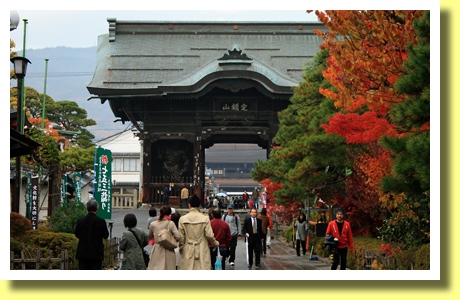
It is about 2km from JR ( Japan Railways ) Nagano Station to Zenko-ji Temple. In 30 minutes after walking from the staion, visitors would see Niomon Gate ( above ) of the temple. The gate was rebuilt in A.D.1864. Niomon, the 1st gate of the temple, houses a pair of Nio ( or Kongo Rikishi ) statues, who guard the temple. They are muscular guardians of Buddha.
|
|
Sanmon Gate of Zenko-ji Temple
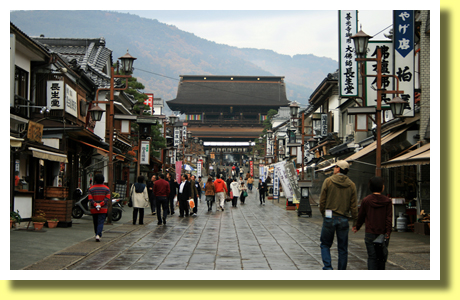
The part of the approach between Niomon Gate and Sanmon Gate ( above ) is called Nakamise Dori ( Street ), which is lined with dozens of shops and small restaurants. The stone pavement of Nakamise Dori was completed in A.D.1714. Sanmon Gate ( the 2nd and main gate of the temple ), built in A.D.1750, is one of designated Important Cultural Properties of Japan.
|
|
Main Hall of Zenko-ji Temple
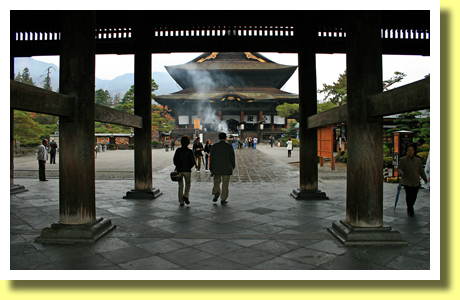
Upon stepping into the Sanmon Gate, visitors would see the Main Hall ( above ) of Zenko-ji Temple. The structure, completed in A.D.1707, is one of the designated National Treasures of Japan.
Since the temple was relocated to the present site in A.D.642, the main hall and other buildings have been destroyed and rebuilt repeatedly. In A.D.1179 the compound was burnt down. In the 16th century, the temple was involved in the battles between Shingen Takeda and Kenshin Uesugi, which made the temple ruinous.
In Edo ( Tokyo now ) in A.D.1603, Ieyasu Tokugawa establishes Tokugawa Shogunate, which helped the temple revive. The Main Hall was rebuilt in A.D.1666 and in A.D.1707. In A.D.1847, an earthquake destroyed Niomon Gate, though the Main Hall and Sanmon Gate survived. Niomon Gate was rebuilt in A.D.1847.
|
|
Incense Smoke

Before stepping into the Main Hall, people rub the incense smoke ( above ) on their bodies as praying for fortune, health and so on. It was in the 6th century that incense burning was brought to Japan together with Buddhism. ( ==> A History of Japan vol.1 Formation of Japan )
|
|
Kyozo
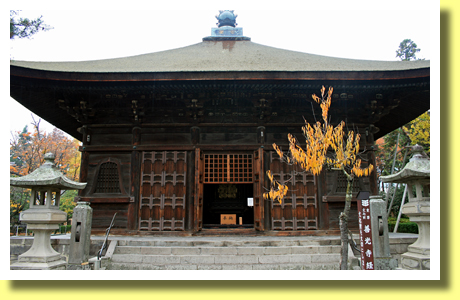
In Zenko-ji Temple, there are many more to see - such as Kyozo ( above ), which is one of the designated Important Cultural Properties of Japan. "Kyo" in Japanese means "Sutra" while "zo" does "storehouse or container", so "Kyozo" is a building to store Buddhist Sutra. Kyozo, built in A.D.1759, contains the octagonal Sutra holder, made in A.D.1694, which visitors could rotate.
|
|
Kawanakajima

Kawanakajima, located in the south of Nagano City, is the site of battlefield where Shingen Takeda and Kenshin Uesugi fought repeatedly in the 16th century. In Kawanakajima, there are statues of them ( above ). It is said that they are two of the strongest warring lords in Sengoku Jidai ( age of warring states ) in Japan. However their battles involved Zenko-ji and made the temple ruinous. ( ==> A History of Japan vol.2 Samurai Age )
|
|
Apples
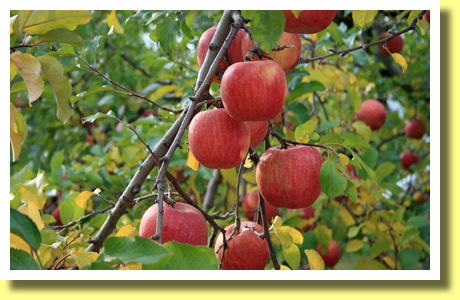
Nagano Prefecture is one of the best and largest apple producing areas in Japan. So in the suburbs of Nagano City, there are lots of apple trees and visitors could see so many apples ( above ) in the season. It is good opportunities through late august - early december in Nagano City, not only to eat tasty apples but also to experience picking apples, which could be arranged by some travel agents.
|
|
Oyaki

Oyaki ( above ) are popular in and unique to Nagano Prefecture. Oyaki are a kind of dumpling made from buckwheat dough and stuffed with local vegetables. There are oyaki stuffed with anko ( red bean paste ) and/or fruit. There are many shops/restaurants serving Oyaki in Nagano City.
|
|
Soba
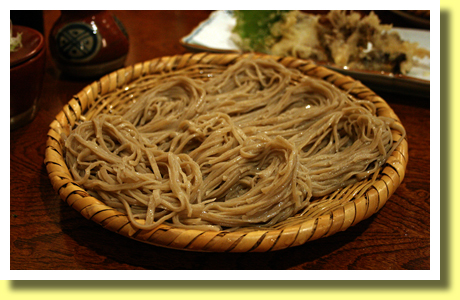
Nagano is a mountainous prefecture as well as its climate is cold. So it was not easy in the prefecture to produce plenty of rice. Instead they lived on buckwheat dishes such as soba noodles ( above ), Oyaki and so on more than in other prefectures. Soba served in Nagano is one of popular noodles in Japan.
|
|
Miso
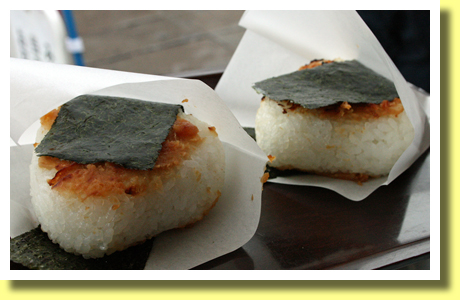
Shinano or Shinshu ( now Nagano Prefecture ) is also famous for Miso ( soybean paste ). So on the way to/from Zenko-ji Temple, tourists could see some shops selling Miso products such as Suyakame who have produced various kinds of Miso products in Nagano City for more than 100 years. The above shows grilled rice balls topped with Miso and Nori ( seaweed laver ). The fragrance of grilled Miso is appetising.
|
|
Basashi ( Horse Meat Sashimi )
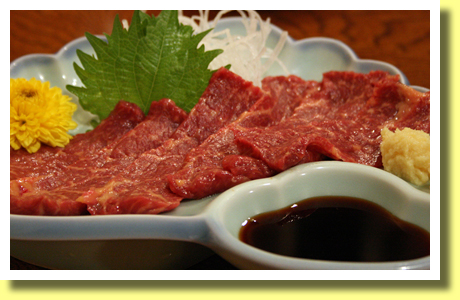
It is said that in the world there are many prople who never eat horse meat. Also in most of 47 prefectures in Japan it is not so easy to find restaurants which serve horse meat. Nagano prefecture is one of some exceptions. In Nagano City, there are many restaurants which serve tasty horse meat dishes such as Basashi ( horse meat sashimi - above ). Basashi served in Nagano is one of local specialty dishes in Japan.
|
|
Shichimi
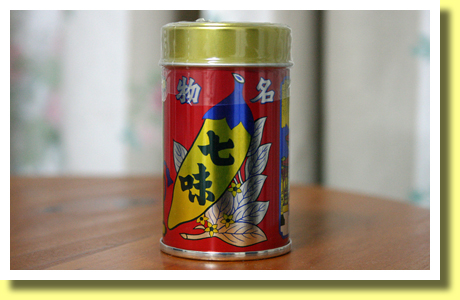
Near Zenko-ji Temple, tourists could find a shop whose name is "Yawataya Isogoro", who has been a Shichimi producer since A.D.1736 and who is one of the most famous Shichimi producers in Japan. The above photo shows one of their Shichimi products.
"Shichimi" or "Shichimi Togarashi" is a Japanese spice. "Shichimi" in Japanese means "seven ingredients" while "Togarashi" does "chili pepper". So Shichimi is a mixture of seven kinds of spices such as red chili pepper, sesame seed, orange peel, ginger and so on, though each Shichimi producer has their own recipe.
Shichimi could be used for Yakitori ( grilled chicken on skewers ), Udon noodle soup, soba noodle soup, beef bowl and so on. Shichimi could be one of souvenirs from Nagano.
|
Copyright (c) 2021 Achi-Kochi Zanmai Co., Ltd.
|